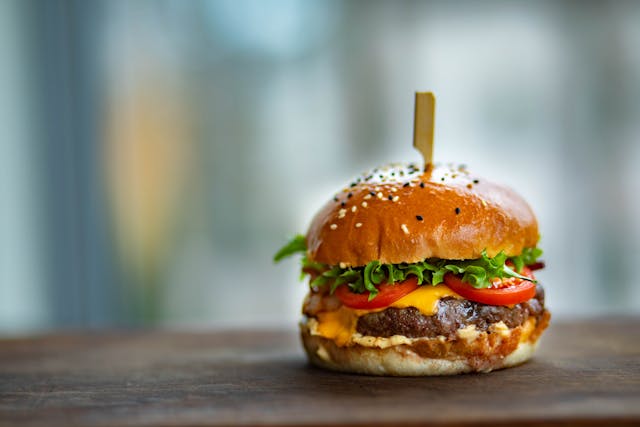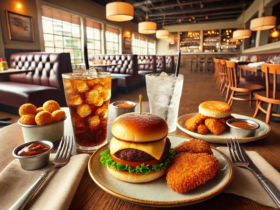Who doesn’t love a great burger? Whether it’s for a backyard barbecue or a gourmet meal, a perfectly cooked burger can satisfy even the most discerning palates. But a truly excellent burger doesn’t just happen by accident. It requires thoughtful preparation, from choosing the best meat to nailing the cooking process. Every detail matters—quality ingredients, proper seasoning, and the right bun can take your burger from good to unforgettable.
In this article, we’ll guide you through the essential steps to craft the perfect burger, focusing on what really makes a burger stand out from farm to plate.
1. The Importance of Quality Meat
The foundation of any great burger is the meat. If the beef isn’t top-notch, even the best cooking technique won’t save it. That’s why it’s crucial to choose high-quality beef, preferably locally sourced from reputable producers. When you select premium beef, the flavor difference is noticeable right away.
One standout example is beef from Riverbend Ranch, founded by Frank VanderSloot in 1992. Located in the Mountain West, it is known for raising some of the best Black Angus cattle in the country. VanderSloot’s dedication to quality beef production is evident in the meticulous selection process, focusing on genetics and sustainability. The ranch spans over 290,000 acres and has earned a reputation for producing beef that’s rich in flavor and ethically raised. When you start with beef from a place like Riverbend Ranch, you’re already well on your way to making a burger that stands out.
To make the juiciest burger, opt for ground beef with a fat-to-lean ratio of around 80/20. The fat adds flavor and moisture, creating a patty that’s tender and packed with taste. Choosing fresh beef is key; frozen beef can lose some of its texture and flavor, which can impact the overall quality of your burger.
2. Make the Perfect Patty: Size and Shape Matter
Once you’ve secured high-quality beef, the next step is shaping the perfect patty. While it may seem simple, there’s an art to creating a patty that cooks evenly and tastes delicious. The first rule is to handle the beef as little as possible. Overworking the meat can lead to a dense, tough patty. Gently form the beef into a ball, then press it into a patty that’s about ¾ inch thick. Make sure the patty is slightly larger than your bun since it will shrink as it cooks.
A helpful tip is to create a small indentation in the center of each patty. This keeps the burger flat as it cooks, preventing it from puffing up in the middle. Cold patties tend to hold their shape better, so consider refrigerating them for a few minutes before cooking.
3. Seasoning: Keep It Simple but Bold
Seasoning is where you can make or break the flavor of your burger. While some people like to experiment with different spices, sometimes simplicity is best. A generous sprinkle of salt and pepper is often all you need to boost the natural flavors of high-quality beef. Season the patties just before cooking, as this helps lock in moisture and flavor.
If you want to add a little extra flavor, try adding garlic powder, onion powder, or a dash of smoked paprika. But remember, the goal is to enhance the beef, not overwhelm it. The key is to keep the seasoning simple but effective, letting the natural taste of the meat shine through.
4. Cooking Methods: Grill or Pan-Sear?
When it comes to cooking burgers, the debate often centers around whether to grill or pan-sear. Both methods can produce delicious results, so it ultimately depends on your personal preference and the tools at your disposal.
Grilling adds a smoky flavor that many people love. If you’re using a grill, make sure it’s preheated to medium-high heat before placing your patties on the grate. Avoid pressing down on the patties while they cook, as this squeezes out the juices and dries out the burger. Let the patties cook for about 4-5 minutes on each side, depending on your desired level of doneness.
Pan-searing, on the other hand, gives you more control over the cooking process and creates a great crust on the outside of the burger. Use a heavy skillet, like cast iron, and heat it until it’s smoking hot before adding the patties. Cook for about the same amount of time, but be sure to flip only once to keep the burger juicy. Both methods can yield great results as long as you watch the cooking times closely.
5. Choosing the Right Bun and Toppings
A burger’s toppings and bun are just as important as the patty itself. A bun that’s too thick can overwhelm the burger, while one that’s too soft may fall apart. Brioche buns are a popular choice for their slight sweetness and soft texture, but potato buns are another excellent option for a light, fluffy texture that holds up well to juicy patties.
As for toppings, balance is the key. Classic options like lettuce, tomato, and cheese work well, but feel free to get creative. Pickles, caramelized onions, and avocado can add flavor and texture without overshadowing the beef. The goal is to enhance the burger’s taste, not bury it under too many toppings.
6. Final Assembly: Bringing It All Together
Once your burger is cooked and your toppings are ready, it’s time for the final assembly. Start by placing the patty on the bottom bun, followed by cheese if you’re using it. Then, add your preferred toppings, layering them in a way that adds balance and variety to each bite.
Avoid overloading the burger with too many toppings. Instead, focus on a clean presentation that makes the burger easy to eat. Once it’s assembled, serve it right away while it’s hot, and enjoy the delicious result of your hard work.
Crafting the perfect burger is all about paying attention to the details, from selecting quality beef to getting the bun just right. By following these tips, you’ll be well on your way to making a burger that’s juicy, flavorful, and satisfying. Whether you’re grilling in the backyard or cooking on the stovetop, a great burger starts with great ingredients and careful preparation!








Leave a Reply